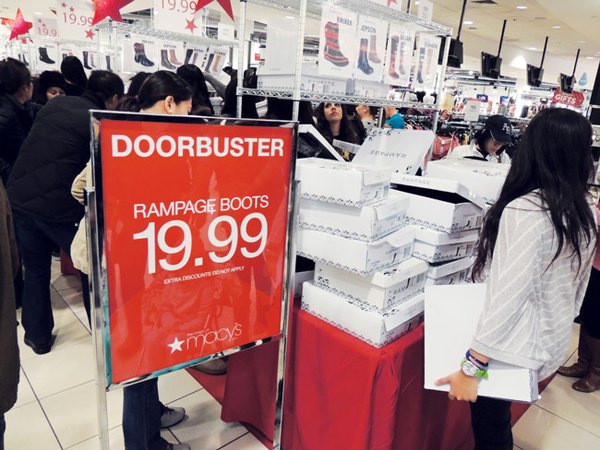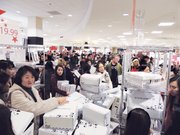BLACK FRIDAY: Like many retailers, Macy’s opted to open on Thanksgiving night this year, giving consumers a head start on Black Friday shopping. The early opening was a success. The Macy’s location at South Coast Plaza in Costa Mesa, Calif., was packed with shoppers looking for a deal.
HOLIDAY FORECAST
Holiday Forecast: After Mixed Black Friday, Retailers Push for More Business
After a tumultuous beginning of the holiday retail season on Black Friday, Nov. 29, retailers are wondering how the crucial month of December will play out.
Unlike robust Black Fridays of previous years, sales results this year read like headlines from a manic stock market.
An estimated 141 million people shopped in malls and on retail streets during Thanksgiving weekend and Black Friday, which is considered the traditional start of the holiday retail season. But the weekend’s sales declined 2.9 percent compared with last year, to $57.4 billion. It was the first time that happened since 2009, during the height of the Great Recession, according to the National Retail Federation, a prominent trade and advocacy group based in Washington, D.C.
However, online retail sales soared and broke records. E-commerce sales on Black Friday skyrocketed to $1.198 billion, which was a 15 percent increase over last year, according to comScore Inc., a Reston, Va.–based company that analyzes e-commerce sales. It was the season’s first billion-dollar day, according to comScore.
The one-two punch of good and bad news underscored some of the issues involved in the biggest sales season of the year, such as the shaky economic recovery and whether big promotions will hurt retailers’ business.
The NRF is predicting the holiday retail season will end on a positive note, said Matthew Shay, the organization’s president and chief executive officer. The season’s sales are forecast to increase 3.9 percent compared with Christmas 2012.
“We’re encouraged that we saw increased shoppers,” he said in a Dec. 1 conference call on Black Friday business. “There are positive signs. The overall prediction of growth is on target.”
The International Council of Shopping Centers, another prominent trade group, predicted that retail sales will increase 3.4 percent during the holiday retail season. Jeff Van Sinderen, retail analyst for financial firm B. Riley & Co., forecast that retail sales will perform anemically from 1 percent to 2 percent. However, he considered it a decent performance in light of all the pressure retailers have been working against.
Consumers’ economic anxieties and uncertainty about the future were blamed for a decline in sales during the Black Friday weekend. According to the Consumer Confidence Survey, released by nonprofit business group The Conference Board, consumer confidence declined in November following a similar decline in October.
Stubbornly high unemployment numbers and falling wages across the American economy made people cautious, said Kimberly Ritter Martinez, an economist with the Los Angeles County Economic Development Corp.
“People were out there shopping,” Ritter Martinez said of the Black Friday weekend. “But they made budgets for themselves, and they’re sticking to them. They may have money, but they are hesitant to spend.”
It also was a Black Friday weekend when a lot of people don’t have money. The unemployment rate for the U.S. is 7.3 percent and 9.5 percent in Los Angeles County, according to the Bureau of Labor Statistics. If all the people who stopped looking for work are counted, the number is 13 percent of the U.S. population.
More-promotional year
Another pressure point is the race to offer big promotions, which has seemingly overtaken the entire retail business. During Black Friday, mall-based teen brand Hollister gave a discount of 50 percent off of everything in the store. Macy’s gave 60 percent off of some selected women’s coats. E-commerce store Moose Ltd. gave 35 percent off for its Cyber Monday sale.
NRF’s Shay forecast that retailers’ generous promotions will continue over the next few weeks. “This year is more promotional than last year,” he said.
Retail analyst Van Sinderen wondered if the big discounts will hurt retailers’ bottom lines and eat into their gross margins. “It’s extremely promotional out there,” he said. “The quality of business probably won’t be great.”
With deep discounts being the rule of the day, there’s not much more retailers can do to pull consumers in with lower prices, said Liz Ebert, a principal in the Chicago office of consulting firm North Highland. But retailers can make last-minute differences with their staff. If a store’s staff is well prepared for their jobs and good at communicating with their customer base, sales will increase, she said. “If I had confidence in a store’s planning for the season, I’d focus on how the workforce is treating customers.”
Managers can motivate their sales force by giving incentives for selling certain products, for example. They also can ensure the staff is fully informed on the store’s priorities and plans to increase conversion or convincing consumers to purchase an item after trying it on the shop floor.
Not all bad news
With the daunting news, there are factors working in retailers’ favor. In Southern California, weather turned cool, said Gila Leibovitch, who runs boutiques in Laguna Beach, Calif., and Beverly Center in Los Angeles under the nameplates of Vault and Premier. “Black Friday was especially great at the Beverly Center location due to poor weather. We had rain!” she said. “The bad weather probably forced more shoppers our way.”
One discussion going around retail circles is that business might be better than what analysts have forecast. Retail consultant Ebert felt that the headlines created a gloom. “I’m concerned,” she said of the pace of retail sales. “But I’m not in full handwringing mode. I’d like to see new ways of measuring holiday sales.”
She noted current methods of measuring holiday sales might not fully count all of the new ways consumers purchase goods from retailers. For example, growing omni-channel retail blends categories such as physical stores and mobile commerce. If all the different categories of retail were counted as one, it would show a more robust number, she said. The NRF’s Shay also said that the separate categories were not giving the most accurate picture of retail.
“All of those platforms must be integrated,” he said. “They must be seamless from one platform to the next.”

























